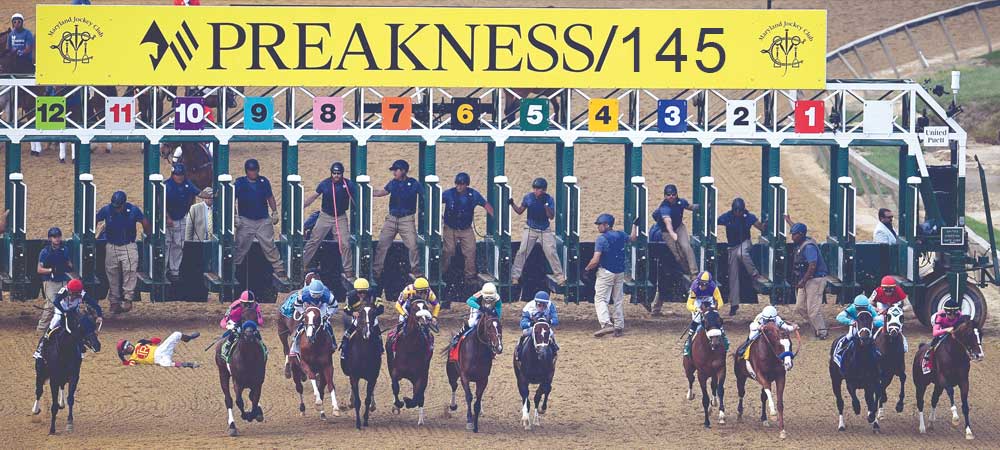Baltimore, MD - While many operators only see dollar signs when considering regulated sports betting, Pimlico Race Course sees the activity as a lifeline. With uncertainty surrounding the how long the historic racetrack will be home to the Preakness Stakes, many are wondering if sports betting in Maryland could tip the scales back in Pimlico’s favor.
The Original Home Of The Preakness Stakes
The Preakness Stakes was inaugurated in 1873 and has been consistently hosted by Pimlico Race Course in Baltimore since 1909. The iconic race takes place just two-weeks after the Kentucky Derby, drawing more than 100,000 spectators to the city of Baltimore each May.
Many consider the legendary race to be the Super Bowl of the Baltimore horse racing industry, with bettors wagering around $4.76 billion on the most recent NFL championship game.
“We are one of the jewels for the Triple Crown. That’s major” stated Catherine Pugh, Mayor of Baltimore.
The sport of horse racing has waned in popularity overall, but the Preakness Stakes is still the second most-viewed horse racing event in the United States.
The Problem With Pimlico
Pimlico Race Course was built in 1870, making the venue 148 years old. There have been minor updates throughout the years that include new LED boards, expanded seating, and standard maintenance, but at its old age, the venue is in need of a major facelift.
The Maryland Stadium Authority initiated a study that estimates a $250 million to $320 million price tag on the necessary renovations. The Stronach Group, which owns both Pimlico and Laurel Park, has already disclosed that they do not anticipate being the primary investor to cover the costs.
Finding partners to finance the renovations could prove to be difficult, considering that the Preakness is the main event of the year and the track only has 12 live racing days scheduled for 2018.
Pimlico’s agreement to host the second jewel of the Triple Crown will come to an end in 2019, and the Stronach Group will have to make the decision to either go through with the overhaul or potentially move the race to Laurel Park.
The recent Supreme Court ruling to lift the federal prohibition on sports gambling could make Pimlico more attractive to investors, if the venue were licensed to accept sports wagers.
Allowing patrons to bet on sports would undoubtedly draw in more customers to the racetrack, giving customers an entirely new betting experience.
There is already a built-in fan base, with the city being home to the Baltimore Ravens and Baltimore Orioles. Football, in particular, is the biggest moneymaker at Nevada sportsbooks, with $1.7 billion bet on professional and collegiate teams in 2017.
Baseball has also shown increased wagering interest with a record $1.1 billion collected by Nevada sportsbooks during the same period.
While Pimlico is only one location and would realistically bring in comparatively small numbers, the handle and additional revenue would make backers feel as if they were getting more of a return on investment.
So Is Sports Betting The Answer?
While offering sports betting would help the case to keep the Preakness at Pimlico, there may not be enough time to make it happen.
Maryland has not yet legalized sports betting, and will not be able to discuss doing so until the 2019 legislative session.
The General Assembly was not able to come to an agreement regarding MD HB 1014 , a sports betting bill that could have potentially legalized sports gambling via a voter referendum in November.
Unless a special legislative session is called, Maryland residents will not be able to vote on any potential gambling expansion until 2020. Even then, it’s not guaranteed that racetracks would be authorized to accept bets on sports.
With the Preakness Stakes only contractually obligated to remain at Pimlico Race Course until 2019 and a decision likely to be made well before the deadline, the timing may be off for sports wagering to be a consideration in negotiations for the race staying put.
Other Ways For The Preakness Stakes To Remain
That being said, there are still other reasons for the Preakness Stakes not to leave Charm City. The 100+ years of tradition is the main driving factor, with fans, breeders, and even trainers expressing the sentiment.
“They better take 143 years of tradition and happy people being able to come here and enjoy it and leave it right where it is,” stated Hall of Fame trainer D. Wayne Lukas. “I’d leave it alone.”
Officials in the city are working on ways to monetize Pimlico throughout the year, rather than relying on one weekend to bring in the bulk of the action. If that can successfully happen, the second jewel of the Triple Crown may be able to stay at Pimlico and the venue could still potentially offer sports betting in the future.
“We’re going to make the case that Pimlico should remain in Baltimore where it belongs. There are serious proposals being considered, not specific enough yet to talk about,” said Delegate Sandy Rosenberg. “We are seriously looking at recreational use for the infield year around. We’re talking about jobs for the community, we’re talking about an attraction that would be an asset for the region.”

